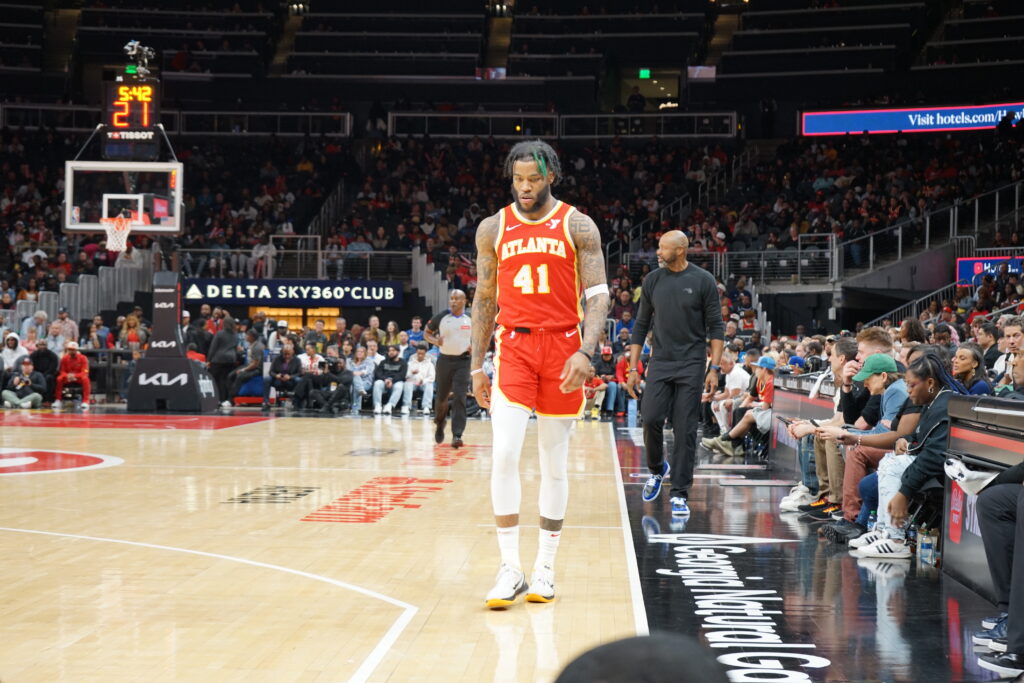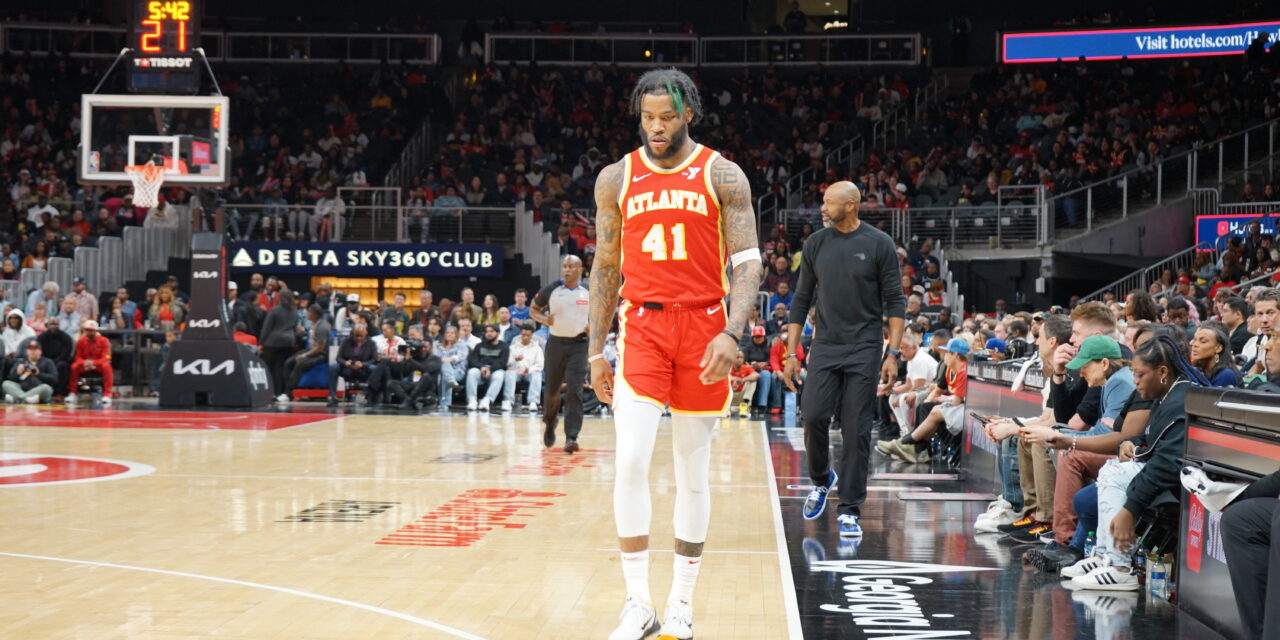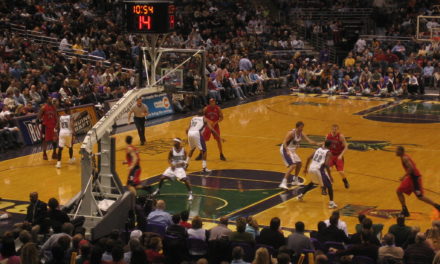
Atlanta Hawks forward Saddiq Bey walks on the court during
a game against the Orlando Magic on Feb. 25. (Justin Whitening/Staff Photographer)
In recent National Basketball Association (NBA) seasons, the league has undergone a profound transformation in scoring. The average points scored per game for teams has soared from an average of 101 in the 2013-14 season to a staggering 114.7 in the 2023-24 season, as of press time. This notable increase in offensive output has sparked fervent debates among fans, analysts and players, prompting inquiries into its root causes and implications for the game.
Remarkable individual performances exemplify the surge in scoring. In January alone, four players transcended the 60-point threshold in one game within just four days. This feat, achieved by only 36 players in the 78-year history of the NBA, underscores the magnitude of the scoring explosion gripping the league. Philadelphia 76ers forward Nicolas Batum, a seasoned NBA veteran, encapsulated the prevailing sentiment when he told reporters during a game in January that “70 is the new 50.”
This sentiment reflects the shifting paradigm in basketball. High-scoring performances once deemed exceptional are now becoming increasingly commonplace, and offensive proficiency is celebrated and revered like never before. Amid the euphoria surrounding the scoring surge, dissenting voices have emerged. Boston Celtics guard Jrue Holiday, widely regarded as one of the premier defensive point guards in the league, offered a thought-provoking perspective on the matter, questioning the impact of defensive restrictions on the game.
“People like to see people score 60 and 70 and do all that,” Holiday told reporters. “How are you going to do that if somebody can be physical and be handsy and be aggressive in that way? So, I personally don’t think that the balance is there.”
The NBA’s concerted efforts to curb physicality and promote offensive fluidity have contributed to the scoring boom. Holiday’s statement underscores concerns regarding the perceived erosion of defensive integrity in favor of offensive spectacle.
Why the scoring boom has occurred
Rule changes in 2004 and 2016 aimed at limiting hand-checking and illegal defense have afforded offensive players greater freedom to maneuver and create scoring opportunities. While these adjustments have undoubtedly enhanced the entertainment value of the game, they have also raised questions about the balance between offense and defense.
However, we cannot attribute the scoring boom solely to the newfound softness of the league. In recent years, there has been a pronounced emphasis on three-point shooting, spacing and pace. Teams are increasingly prioritizing efficient scoring opportunities, such as layups, dunks and three-pointers over mid-range jump shots. NBA teams were only averaging 2.4 three-point attempts per game in the 1983-84 season. In the 2022-23 season, Golden State Warriors guard Klay Thompson alone averaged 10.6. Teams averaged 34.2.
Moreover, the emergence of transcendent talents who possess unparalleled offensive versatility, like Golden State Warriors guard Stephen Curry and Denver Nuggets center Nikola Jokic, has further catalyzed the scoring explosion. Traditional defensive strategies have proven ineffective against modern offenses that prioritize perimeter scoring and ball movement. Consequently, teams have experimented with new defensive tactics, such as switching defensive assignments, zone defenses and trap schemes, to contain these elite scorers.
However, these defensive adjustments have often been outpaced by offensive innovations, including teams implementing big men who traditionally played a more defensive role into their offensive foundations. With the increased emphasis on three-point shooting and perimeter skills, traditional big men are facing pressure to adapt their games to fit the modern style of play. This shift could potentially limit opportunities for players who excel in traditional post-up and mid-range play, altering the talent pool and diversity of playing styles in the league.
Take, for example, the San Antonio Spurs’ 20-year-old center Victor Wembanyama. Standing at a whopping 7 feet 4 inches tall, most fans would expect him to play the traditional center role, focusing on rebounding and layups like most players his size. However, he sometimes operates as the Spurs’ point guard as well, averaging 1.7 threes made off of 5.2 attempts each game and averaging four assists per game.
This would have been unheard of for a player like Wembanyama 20 years ago. But now, with players like Jokic — a 7-foot big man and two-time NBA most valuable player averaging 25.9 points, 12.2 rebounds and 9.1 assists this season — the league can truly flourish with big men leading the way, subsequently increasing the points scored in a game.
Implications of the surge
The scoring boom in the NBA has significant financial implications for the basketball industry. Firstly, the boom enhances fan engagement, making games more exciting and attracting higher viewership, which translates into increased revenues from ticket sales, merchandise and sponsorships. Higher viewership makes broadcasting and streaming rights more valuable, resulting in more lucrative deals for the league and its teams.
Player salaries increase as star players who excel in scoring become more sought after by teams and sponsors, driving up their market value. The league’s international appeal could grow as well, attracting more global viewership and opening up new markets for the NBA. Finally, fantasy sports and sports betting markets can benefit from the unpredictability and excitement of higher-scoring games, driving revenues for fantasy sports platforms, betting operators, associated advertisers and sponsors. Overall, an NBA scoring boom can have a multifaceted financial impact, benefiting various stakeholders and further strengthening the league’s position in the sports industry.
As an NBA fan, I see the scoring boom as a double-edged sword. On one hand, it injects thrilling energy into the game, especially during moments when every shot matters. I find myself eagerly anticipating each basket, particularly in the final minutes of close games. However, while offensive prowess is undoubtedly exhilarating to behold, I cannot ignore the downside. With the increasing emphasis on offense, there seems to be a gradual erosion of appreciation for defensive prowess. Spectacular 60 to 70-point performances, once rare and awe-inspiring, now seem almost routine. This normalization of high scores might lead fans to undervalue the defensive efforts required to contain such prolific scoring.
In essence, while I enjoy the heightened excitement that the scoring boom brings, I also worry about its long-term effects on the perception of defensive play. Maintaining the integrity and excitement of the game hinges on striking a delicate balance between offensive firepower and defensive tenacity. As the NBA evolves, this equilibrium becomes increasingly crucial for ensuring the sport’s continued success and longevity.






